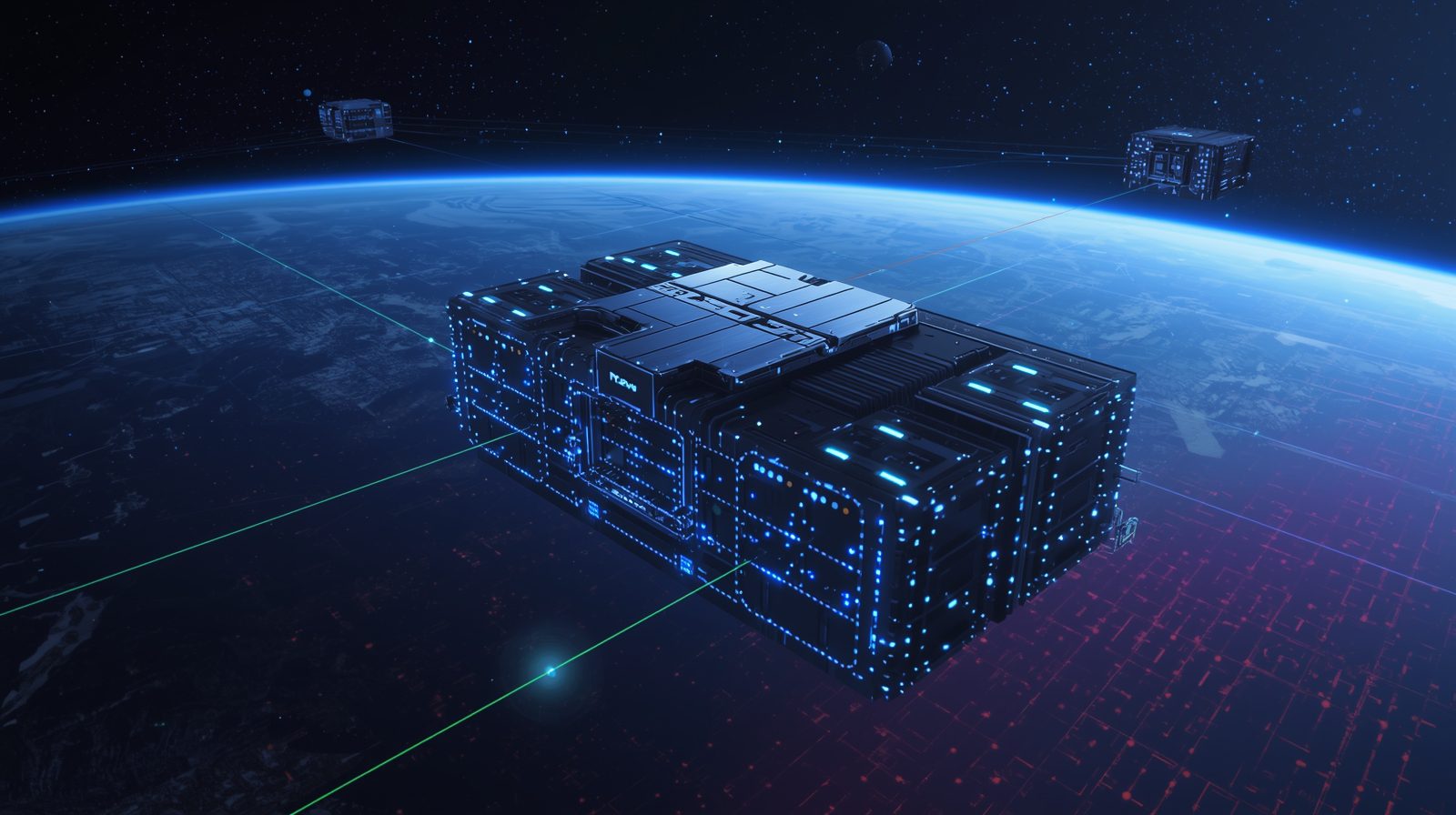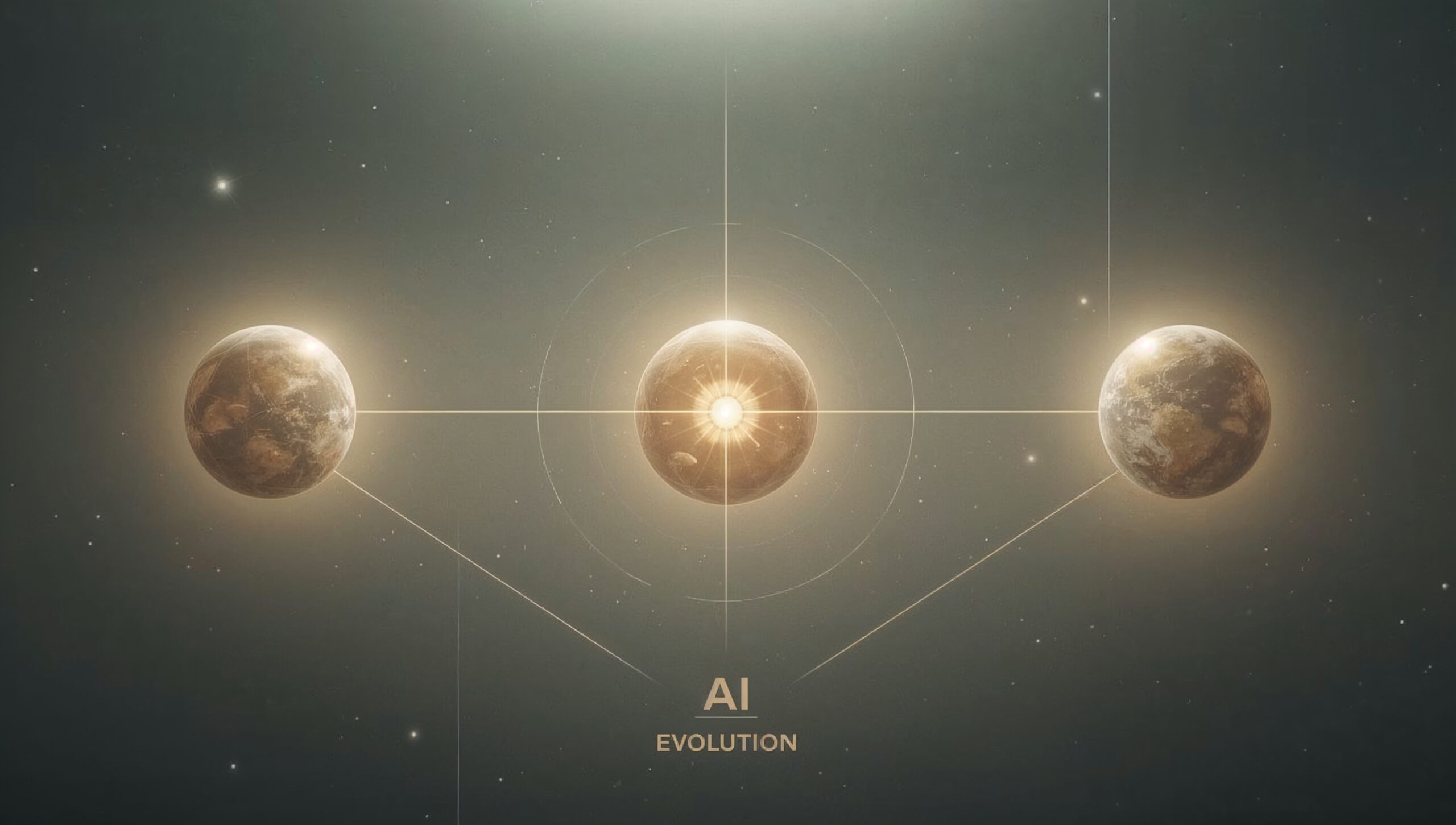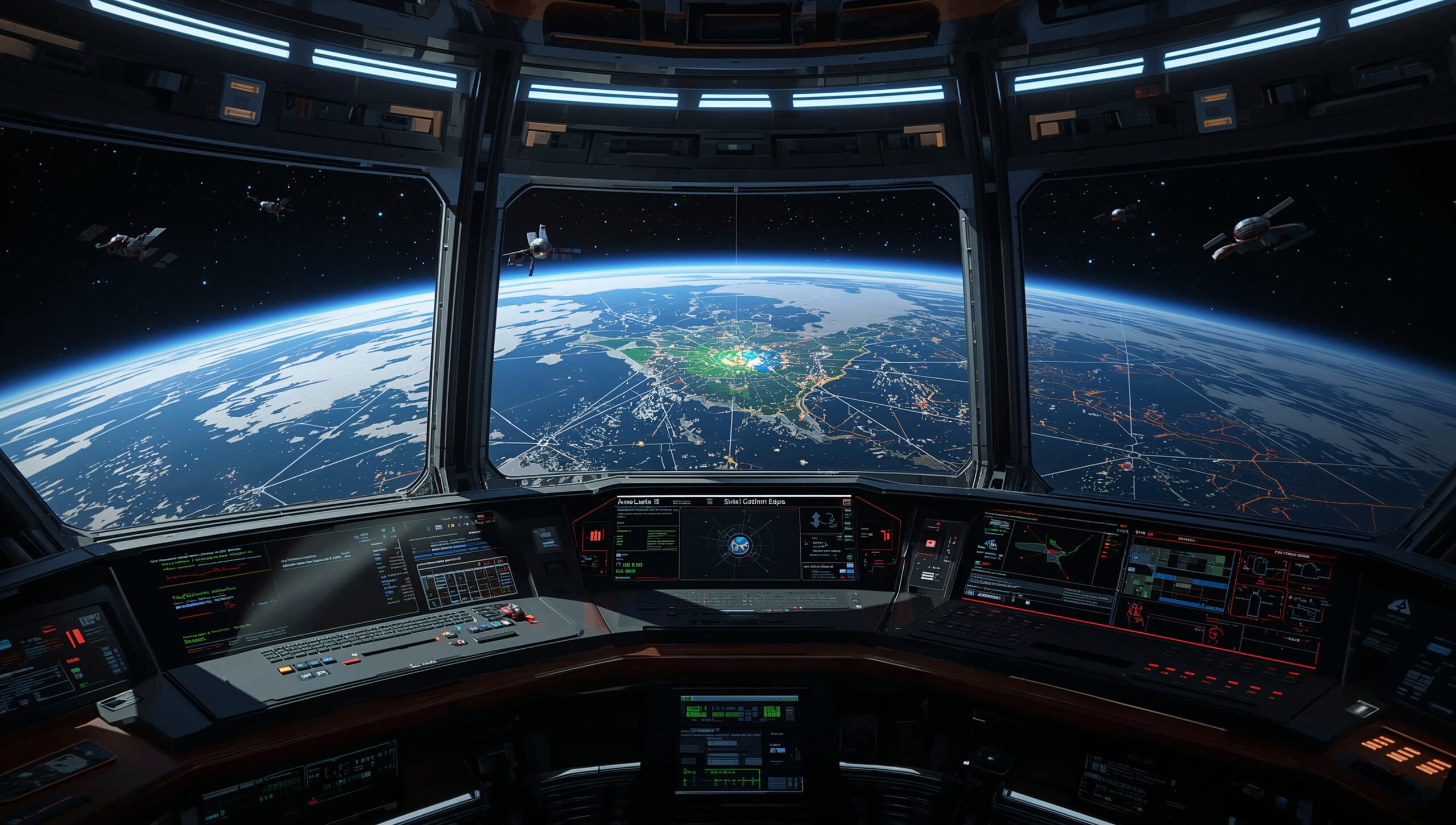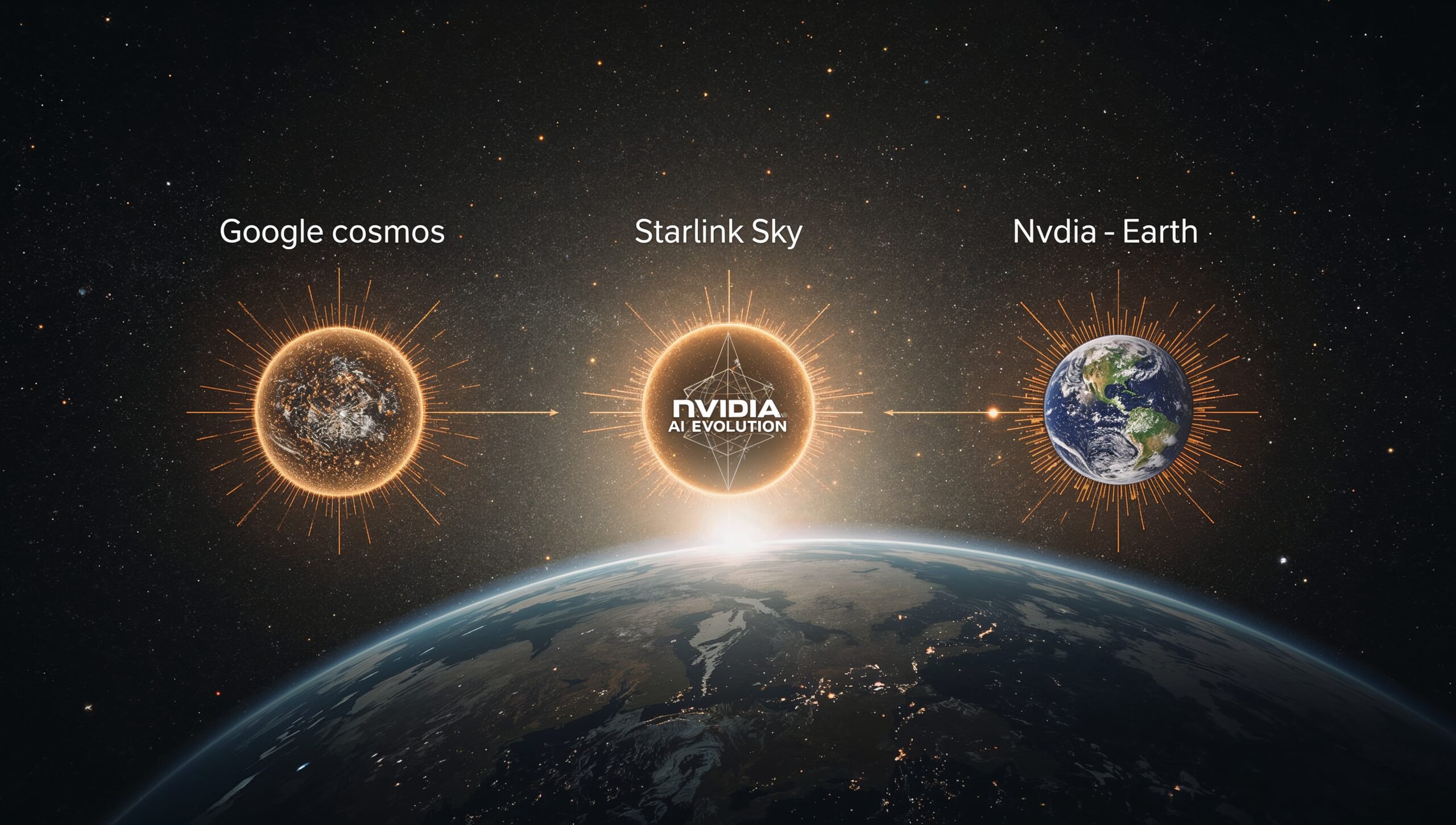The Orbital Computing Revolution: Why Space Datacenters, Starlink, and 6G Are Actually One Story.
November 2025 dropped three announcements that most people are treating as separate news items. They’re not. They’re the same story.
Google unveiled Project Suncatcher – datacenters in orbit running on continuous solar power. Nvidia dropped $1 billion into Nokia to build AI-native 6G networks. Meanwhile, SpaceX quietly assembled 7,600 satellites into a 450-terabit-per-second mesh network floating above us. Connect the dots, and you’re looking at a complete infrastructure stack that solves three problems terrestrial computing can’t crack: power constraints, network latency, and global connectivity gaps.
This isn’t science fiction anymore. It’s engineering economics finally making sense.

Google’s betting on solar power that never sleeps.
Here’s what Google figured out: solar panels in sun-synchronous orbit are eight times more productive than anything on Earth. No clouds. No night. Just continuous power hitting your panels while the Sun pumps out more energy than 100 trillion times what humanity uses.
Project Suncatcher launches two prototype satellites in early 2027, each carrying four Trillium TPUs – Google’s sixth-gen tensor processors built for machine learning. They’re testing something everyone said was impossible: running AI workloads in space without melting the hardware or getting fried by radiation.
The radiation testing surprised everyone. They blasted these TPUs with a 67 MeV proton beam at UC Davis – simulating five years in orbit. The chips didn’t hard-fail until 15 kilorads, way beyond mission requirements. Turns out TPUs are naturally radiation-hard enough for space applications. Who knew?
The catch? Launch costs need to hit $200 per kilogram – a 7.5x drop from today’s SpaceX Falcon Heavy pricing. At that threshold, Google’s math says space datacenters become cost-competitive with terrestrial facilities on a per-kilowatt basis. They’re betting Starship’s full reusability gets them there by mid-2030s with 180 launches annually.
The bigger challenge is cooling. On Earth, air moves heat away. In vacuum, you’ve only got infrared radiation. The ISS needs 477 square meters of radiators for 75 kilowatts of cooling – roughly a basketball court for equipment that wouldn’t fill a closet. Scale that to the 100+ megawatt datacenters AI demands, and you’re looking at radiators the size of city blocks. Google’s banking on “advanced thermal interface materials and passive systems,” which is engineer-speak for “we’re working on it.”
But here’s why they’re pushing forward: Google’s terrestrial datacenter energy consumption jumped 114% from 2020 to 2024, hitting 30.8 million megawatt-hours annually. The grid can’t keep up. Power is the bottleneck, not compute capacity. Space solves that fundamental constraint.
Starlink already built the network everyone else is planning
While Google’s testing prototypes, SpaceX already deployed the infrastructure. Starlink operates 7,600 active satellites serving six million customers with median latency of 25.7 milliseconds – a 47% improvement from early 2024 and approaching the 20ms target that makes it competitive with fiber.
For distances over 3,000 miles, Starlink’s orbital paths are 40% faster than fiber optic cables because light travels at 299,792 km/s in vacuum versus only 200,000 km/s in glass. Physics wins.
The network’s 450 terabits per second aggregate capacity adds five terabits weekly through Generation 2 deployments. But the real game-changer drops in 2026: V3 satellites delivering over one terabit per second downlink capacity each – a tenfold jump requiring Starship because they mass two tons. One Starship launch carrying 60 satellites adds 60 terabits of capacity, twenty times what’s possible with current Falcon 9 deployments.
The secret sauce is the laser inter-satellite link mesh. Each satellite carries three optical transceivers at 200 gigabits per second bandwidth per link. The constellation maintains 9,000+ simultaneous optical connections moving 42 petabytes daily. That’s not just a communication network – it’s a distributed computing fabric already operating at global scale.
For space-based computing, Starlink provides the data relay to and from any point on Earth, including polar regions. The upcoming V3 satellites incorporate next-generation computers and modems for edge computing directly in orbit. Process Earth observation imagery before downlink. Aggregate IoT sensor data globally. Run distributed AI inference with low latency. The infrastructure’s ready. We’re just starting to figure out what to run on it.

Nvidia-Nokia’s 6G bet: The terrestrial-space bridge
The third piece clicked into place October 28, 2025. Nvidia invested $1 billion in Nokia at $6.01 per share, making itself one of Nokia’s largest shareholders. Nokia’s stock jumped 22% that day. This wasn’t a financial play – it was infrastructure positioning.
The partnership integrates Nvidia-powered AI-RAN products into Nokia’s radio access network portfolio. Nvidia’s ARC-Pro platform performs full Layer 1 RAN processing directly on Blackwell GPUs while Nokia’s anyRAN software runs Layers 2 and 3 on Nvidia’s Grace CPUs. This software-defined approach means zero-touch upgrades from 5G to 5G-Advanced to 6G as standards evolve – no equipment replacement cycles gutting operator budgets.
Here’s what matters: 6G specifications explicitly incorporate Non-Terrestrial Networks through 3GPP’s integrated satellite-terrestrial network architecture. The vision combines ground-layer terrestrial base stations, air-layer UAVs and high-altitude platforms, and space-layer satellites across LEO, MEO, and GEO orbits into unified infrastructure. 6G networks are designed from day one to treat satellite communications as integral components, not exotic add-ons.
Commercial deployment targets 2030, aligned with ITU-R’s IMT-2030 designation. Technical capabilities include terabit-per-second wireless links – demonstrated speeds from 12 gigabits per second to 240 gigabits per second depending on distance and frequency. The “Golden Band” of 7.125-8.4 gigahertz emerged from World Radiocommunication Conference 2023 as globally harmonized primary spectrum.
This is the bridge. 6G connects space-based compute to terrestrial devices. Starlink provides the orbital mesh. Google’s datacenters do the heavy processing. Nvidia-Nokia’s 6G handles the last mile. It’s a complete stack.

Why is this convergence happening now?
Three technology curves just intersected. Launch costs dropped tenfold over two decades. AI workloads exceeded grid capacity to accommodate them. Satellite constellations reached density for continuous global coverage. These aren’t separate trends – they’re mutually reinforcing.
SpaceX achieved 87% of all global upmass launched in 2023. That monopoly on access to orbit creates winner-take-most dynamics. Goldman Sachs projects 165% increase in datacenter power demand by 2030, while 72% of survey respondents cite power and grid capacity as “very or extremely challenging.” Grid connection requests require 4-7 years in key regions like Virginia. Google exited 2024 in a “tight supply-demand situation” with capex surging from $52.5 billion in 2024 to a projected $75 billion in 2025 – a 42% increase driven by AI infrastructure constraints.
The timing isn’t coincidental. McKinsey and the World Economic Forum project a $1.8 trillion space economy opportunity through 2035. Early infrastructure owners will capture disproportionate value. We’re in a land-grab phase where the next 3-5 years determine who owns the rails for the next 30.
What this means for the Sunshine Coast (and everyone else)
Australia’s positioning in this convergence presents advantages most regions don’t have. Queensland offers direct equatorial orbit access at latitude comparable to Cape Canaveral, combined with clear skies and open waters to the east. The Sunshine Coast specifically has world-class digital infrastructure: the Japan-Guam-Australia South submarine cable providing fastest east coast connection to Asia, NEXTDC’s SC1 Tier 3N+1 Edge Data Centre, city-wide fiber broadband and WiFi 6 in Maroochydore.
University of the Sunshine Coast’s Space to Sea accelerator launched in May 2025 with Queensland Government funding, supporting eight companies including QL Space for Earth-observation analytics and Space Focus Australia for ISO-compliant geospatial intelligence. The 6-month concept-to-reality timeline competes globally, and graduates leverage submarine cable infrastructure for rapid data exchange with Asian markets valued at $372 billion for Earth observation services.
But here’s the gap: no identified partnerships exist between Sunshine Coast entities and convergence leaders – Google, SpaceX, Nokia, or Nvidia – despite these companies actively seeking global partners and testbed locations. Spiral Blue in Sydney represents Australia’s only explicitly identified space edge computing company. The Sunshine Coast lacks State-funded manufacturing hubs present in six other Queensland regions.
The window’s open right now. Within 1-2 years, regions establishing partnerships and capabilities will capture disproportionate value as convergence accelerates through the 2030s. After that, the infrastructure owners lock in and everyone else becomes a customer.

The reality check nobody wants to hear
Let me be direct: this could all take longer than projected, cost more than estimated, and face physics problems nobody’s solved yet. Communications bottlenecks often erase advantages of space computing – if data can’t move in or out quickly enough, unlimited solar-powered processing provides limited value. The scale gap between terrestrial datacenters operating at 50+ megawatts and the few kilowatts deliverable per heavy-lift launch spans multiple orders of magnitude.
Space debris poses collision risk. Damaging radiation demands constant mitigation. Extreme thermal swings complicate cooling. Maintenance inaccessibility means any malfunction jeopardizes entire systems. Google’s 2027 prototype validates technical approaches, but commercial viability depends on launch cost reductions and Starship operational maturity that may or may not materialize on schedule. Starship’s only had eleven test flights with six successes as of October 2025.
Cybersecurity introduces additional complexity. Satellites, ground stations, communication signals, and supply chains face growing attack surfaces. LEO systems impose discontinuous coverage impacting packet delivery. GEO systems suffer non-terrestrial backhaul limitations. Integration across satellite-aerial-terrestrial layers requires complex coordination that creates vulnerability points.
And the competitive landscape reveals divergent technical approaches. While Nvidia-Nokia pursue GPU-based RAN processing, Ericsson advocates purpose-built EMCA silicon rather than general-purpose GPUs. These architectural disagreements suggest the industry remains in exploratory phase – typical for emerging categories but indicating significant execution risk for any single approach.

Why I’m still paying attention.
Despite the uncertainty – maybe because of it – this convergence matters. When Google commits research teams and partnership capital, when Nvidia invests $1 billion in Nokia specifically for 6G positioning, when SpaceX manufactures six satellites daily while developing Starship to deploy them more economically, these signal conviction that fundamentals shifted sufficiently to justify substantial resource allocation.
The convergence thesis holds that space computing becomes inevitable once launch costs fall below critical thresholds, satellite networks achieve sufficient density, and AI workloads exceed terrestrial grid capacity. Whether that inevitability arrives in five years or fifteen remains uncertain.
But the infrastructure stack taking shape above us – kilometre-scale satellite constellations, laser-linked mesh networks, radiation-hardened AI processors preparing for orbital deployment – represents the foundation for computing paradigms that may define how humanity processes information in the decades ahead.
For enterprise decision-makers, the strategic question isn’t whether to immediately shift workloads to orbital datacentres – they don’t exist commercially and won’t for years. Rather, it’s understanding how this infrastructure evolution affects long-term AI strategy, vendor relationships, and geographic deployment decisions. Organizations signing multi-year cloud commitments should account for potential diversification to space-based capacity once economics prove viable.
Australia doesn’t need permission to join this club – we can build sovereign capability right now.Gilmour Space Technologies on the Gold Coast operates with 150-200 staff manufacturing the Eris orbital launch vehicle using hybrid-propellant engines and 3D-printed solid fuel. They secured Australia’s first orbital launch license and operate the Bowen Orbital Spaceport in North Queensland. The July 30, 2025 test flight lasted 14 seconds – standard for first attempts. SpaceX’s success rate with Starship is still only 55% after eleven flights. The critical point: even minimum-scale orbital launch capability (300kg to LEO) creates sovereign capacity to deploy our own satellites and computing infrastructure without foreign dependence. Combined with the Sunshine Coast’s digital infrastructure and UniSC’s Space to Sea accelerator, we have the pieces to join as value creators with sovereign capabilities – if we move while the window’s open.
”The future's being built right now. The question is who's building it and who's just watching.

#OrbitalComputing #SpaceDatacenters #6G #Starlink #ProjectSuncatcher #AIInfrastructure #SpaceTech #LEOConstellations #Nvidia #Nokia #GoogleResearch #NextGenNetworks #AIRevolution #SpaceEconomy #FutureOfCompute #GlobalConnectivity #SatelliteInternet #AustraliaTech #SunshineCoastInnovation #AICompass

